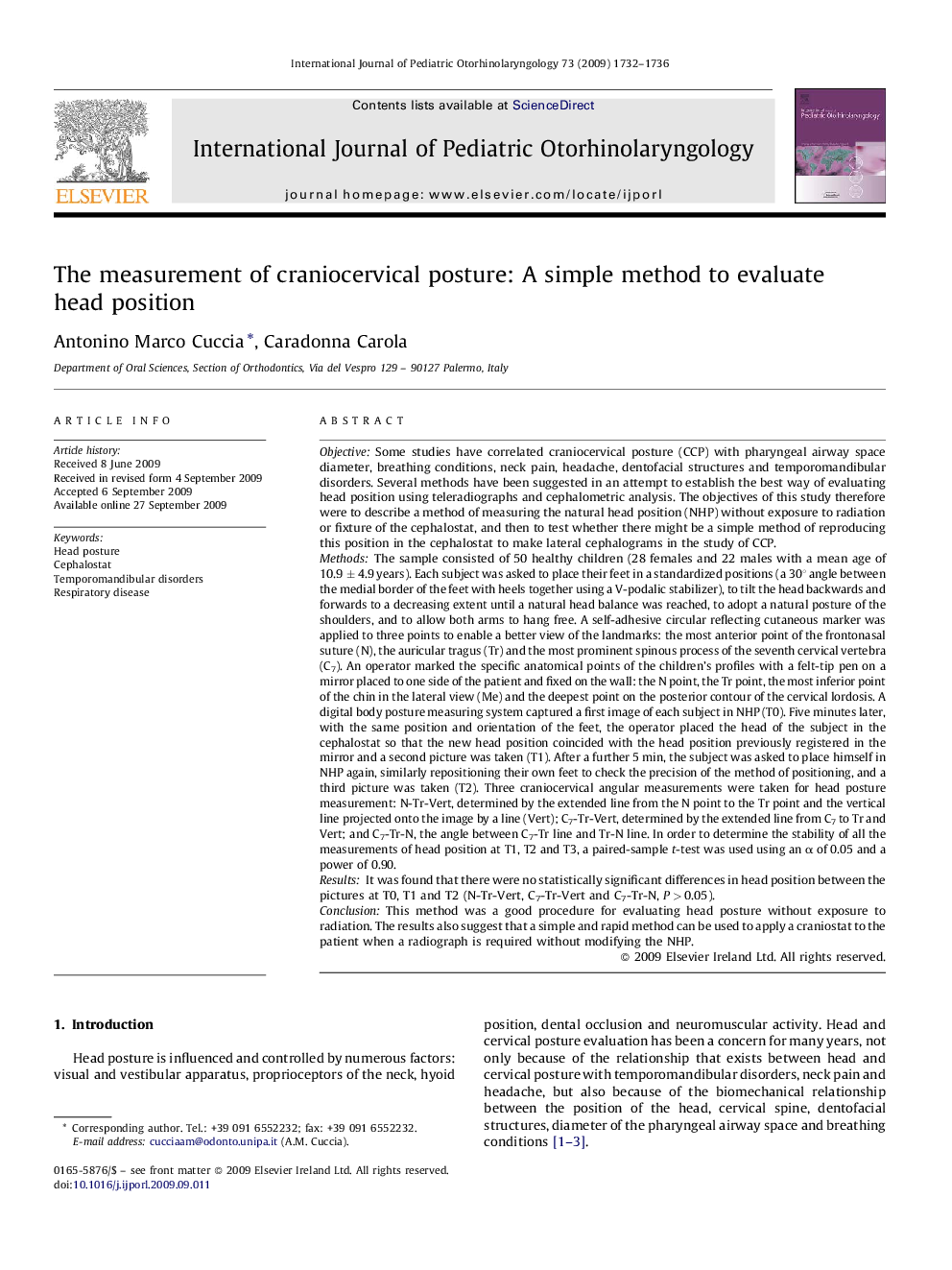| کد مقاله | کد نشریه | سال انتشار | مقاله انگلیسی | نسخه تمام متن |
|---|---|---|---|---|
| 4114802 | 1606063 | 2009 | 5 صفحه PDF | دانلود رایگان |

ObjectiveSome studies have correlated craniocervical posture (CCP) with pharyngeal airway space diameter, breathing conditions, neck pain, headache, dentofacial structures and temporomandibular disorders. Several methods have been suggested in an attempt to establish the best way of evaluating head position using teleradiographs and cephalometric analysis. The objectives of this study therefore were to describe a method of measuring the natural head position (NHP) without exposure to radiation or fixture of the cephalostat, and then to test whether there might be a simple method of reproducing this position in the cephalostat to make lateral cephalograms in the study of CCP.MethodsThe sample consisted of 50 healthy children (28 females and 22 males with a mean age of 10.9 ± 4.9 years). Each subject was asked to place their feet in a standardized positions (a 30° angle between the medial border of the feet with heels together using a V-podalic stabilizer), to tilt the head backwards and forwards to a decreasing extent until a natural head balance was reached, to adopt a natural posture of the shoulders, and to allow both arms to hang free. A self-adhesive circular reflecting cutaneous marker was applied to three points to enable a better view of the landmarks: the most anterior point of the frontonasal suture (N), the auricular tragus (Tr) and the most prominent spinous process of the seventh cervical vertebra (C7). An operator marked the specific anatomical points of the children's profiles with a felt-tip pen on a mirror placed to one side of the patient and fixed on the wall: the N point, the Tr point, the most inferior point of the chin in the lateral view (Me) and the deepest point on the posterior contour of the cervical lordosis. A digital body posture measuring system captured a first image of each subject in NHP (T0). Five minutes later, with the same position and orientation of the feet, the operator placed the head of the subject in the cephalostat so that the new head position coincided with the head position previously registered in the mirror and a second picture was taken (T1). After a further 5 min, the subject was asked to place himself in NHP again, similarly repositioning their own feet to check the precision of the method of positioning, and a third picture was taken (T2). Three craniocervical angular measurements were taken for head posture measurement: N-Tr-Vert, determined by the extended line from the N point to the Tr point and the vertical line projected onto the image by a line (Vert); C7-Tr-Vert, determined by the extended line from C7 to Tr and Vert; and C7-Tr-N, the angle between C7-Tr line and Tr-N line. In order to determine the stability of all the measurements of head position at T1, T2 and T3, a paired-sample t-test was used using an α of 0.05 and a power of 0.90.ResultsIt was found that there were no statistically significant differences in head position between the pictures at T0, T1 and T2 (N-Tr-Vert, C7-Tr-Vert and C7-Tr-N, P > 0.05).ConclusionThis method was a good procedure for evaluating head posture without exposure to radiation. The results also suggest that a simple and rapid method can be used to apply a craniostat to the patient when a radiograph is required without modifying the NHP.
Journal: International Journal of Pediatric Otorhinolaryngology - Volume 73, Issue 12, December 2009, Pages 1732–1736